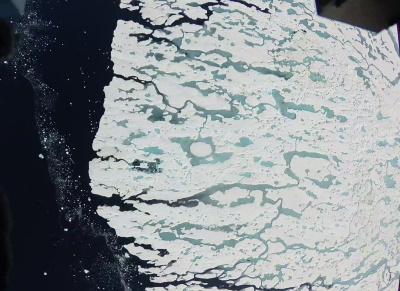- Campaigns
- CryoVEx ICESat-2 Summer 2019
CryoVEx ICESat-2 Summer 2019
Overview
What was the purpose of CryoVEx 2019?

The ESA CryoVEx/ICESat-2 summer campaign 2019 is an add-on to the campaign carried out in spring 2019, which did not cover all the flights that were planned due to weather obstacles.
The aims of this campaign were to:
- Cross validate ESA CryoSat-2 and NASA ICESat-2 mission observations of summer sea ice in the Arctic
- Test a dual-frequency (Ka/Ku-band) airborne radar system developed and operated by the Center for Remote Sensing of Ice Sheets (CReSIS), University of Kansas
The goal was to exploit the concept for future polar satellite missions, i.e. the CRISTAL mission. The campaign involved operations of the CReSIS Ka/Ku-band radar system, and the DTU laser scanner setup using a chartered Twin Otter aircraft (TF-POF) from Norlandair, Iceland. This instrument setup differs from previous CryoVEx campaigns (i.e. CryoVEx/KAREN 2016 fall and 2017 spring, CryoVEx/Antarctic 2017-18, and CryoVEx/ICESat-2 2019 spring), where the Ka- and Ku-band airborne radar altimeters were independent instruments, i.e. the MetaSensing Ka-band radar (KAREN) and ESA’s Ku-band radar (ASIRAS).
Two sea ice flights were flown in the Arctic Ocean out of Station Nord including two near coincident underflights of ICESat-2 and two of CryoSat-2. Transit flights crossing the Greenland Ice Sheet were also used to collect measurements when possible, following flight lines that have been surveyed before. The airborne campaign was carried out during 6 - 16 August 2019. The campaign was coordinated by National Space Institute, Technical University of Denmark (DTU Space) in collaboration with CReSIS, University of Kansas, US.
What was the outcome of CryoVEx 2019?
First results of the CReSIS radar demonstrated that the system has sufficient sensitivity to conduct dual-band altimetry measurements to capture specular returns, i.e. leads and melt ponds over sea ice covered regions.
The CReSIS radar is a classic nadir-looking altimeter, i.e. the current system configuration does not support acquisition in the SAR nor SARIn mode that CryoSat does, and former airborne radars (ASIRAS and KAREN) used in previous CryoVEx campaigns.
The processing is, however, performed with a form of along-track SAR processing to narrow the beam in that direction. A drawback from sub-banded processing to emulate the operating parameters of the ASIRAS and AltiKA instruments, is that the subsurface interface is brighter than the surface, which may lead to ambiguity in the determination of the surface location, whereas the full-bandwidth data resolve both interfaces distinctly.
One of the conclusions in Rodríguez-Morales et al. (2020) is to include lower frequency C/S-band (2 - 8 GHz) to fully utilise the capabilities to capture thin snow over sea ice. However, this would demand an alternative antenna setup for the DTU system, as a third antenna does not fit in the aircraft with the current setup.
Over the East Greenland Ice Sheet the team obtained nearly identical results when comparing the ALS minus Ka‐band radar offsets along the survey line. The mean value of the elevation differences for both comparisons is close to zero, with a standard deviation of 0.71 m. This is expected during summer conditions.
It was also found that the Ku-band is capable of tracking a sub-surface layer at an average depth of 30 cm (assuming the same dielectric constant of 1.53). This sub-surface layer is not visible in the Ka-band.
Download the CryoVEx 2019 Final Report
| Data Coverage (Year) | 2019 |
| Geographic Site | Arctic |
| Mission Instrument | ALS, CReSIS radar |
| Field of Application | Sea and land ice. Radar and laser altimetry |
| Data Size | 50 GB |
Digital Object Identifier: European Space Agency, 2022, CryoVEx/ICESat-2 Summer 2019, https://doi.org/10.5270/ESA-b72e63c
Data
The campaign data is available online via FTPS upon submission of a data access request. An active EO Sign In account is required to submit the request.
The data can be downloaded via an FTP client (e.g., FileZilla or WinSCP) using the option "Implicit FTP over TLS".
Data from the campaign are also available to download from the CS2EO portal.
For further information about the EO Sign In Service you can visit TellUs
Should you need support please contact EOHelp